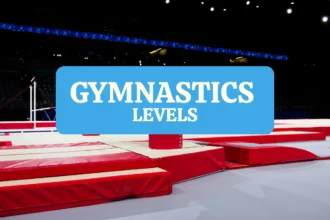In artistic gymnastics, the floor exercise is one of the most dynamic and expressive events, especially in women’s gymnastics. Combining power, flexibility, and rhythm, this event is made even more engaging by an essential element: floor music.
If you’re new to gymnastics or simply curious about how floor routine music works, this guide will break it all down—what the music is, how it’s selected, and why it matters.
What Is Floor Music?
Floor music refers to the instrumental soundtrack that accompanies a gymnast’s floor routine. It sets the tone, enhances performance quality, and helps showcase the athlete’s artistry and personality.
In women’s artistic gymnastics (WAG), music is a required component of the floor routine. In men’s artistic gymnastics (MAG), however, floor routines are performed without music.
Why Music Is a Must-Have in Women’s Floor Routines
A long time ago, gymnastics was just about strength and skills. But over the years, especially in women’s events, music was added to help bring out more personality and style. The music isn’t just background noise. It helps tell a story. The gymnast’s moves are choreographed to go along with the beat, rhythm, and mood of the song. That makes the routine more exciting to watch and helps it stand out.
In competitions, judges score routines on both technical skill and artistic expression. They look at how well the gymnast’s moves match the music, including rhythm and expression. A well-synced routine can boost a gymnast’s score, while a routine that doesn’t flow well with the music may lose points. That’s why music is so important in women’s floor routines.
Rules and Requirements in Women’s Floor Routines
The use of music in women’s floor routines is governed by the FIG (Fédération Internationale de Gymnastique) Code of Points, which sets international standards for competition. Here are the basic guidelines:
- Time limit: The routine must last between 1:20 and 1:30 minutes. Music usually reflects this, with compositions tailored to that range.
- No lyrics: Floor music must not contain vocals or lyrics (words), though it may include vocalizations (like humming or chanting) as long as they don’t form actual words.
- Originality encouraged: Music should match the gymnast’s personality and style. Original or uncommon tracks are often preferred to help a gymnast stand out.
- No live instruments: Music must be pre-recorded and played over the venue’s sound system.
- Timing starts with movement: The timer for the routine starts when the gymnast begins to move, not when the music starts (though these are often simultaneous).
Penalty note: Going over or under the time limit, using music with lyrics, or having technical issues with music playback can result in deductions.
Where Does Floor Music Come From?
The answer is: both! Floor music can be either selected from existing tracks or custom-produced just for a gymnast.
Pre-Made Music (Selected)
Many gymnasts and coaches choose from existing music that’s already edited and approved for gymnastics use. These are often:
- Instrumental versions of popular songs or movie soundtracks
- Classical pieces
- Remixed or rearranged versions made to fit the 90-second time limit
Some websites and companies specialize in gymnastics floor music—like Floor Express Music, JP Music, or Soundtrack Factory—where gymnasts can browse and buy ready-made tracks.
Custom Music (Produced)
At higher levels (like elite or NCAA), some gymnasts get their music custom-made. This means working with a music producer who:
- Edits a song to fit the time limit
- Removes lyrics (since lyrics aren’t allowed)
- Adds dramatic effects or builds in cues for choreography
- Sometimes even creates an original piece from scratch
This option is more expensive, but it helps gymnasts stand out and have music tailored exactly to their style and routine.
Fun Fact: NCAA vs Elite Gymnastics — Two Different Vibes
One of the coolest differences in gymnastics is how floor music is used in NCAA (college) competitions versus elite (international/Olympic-level) ones. Both follow the same rule—no lyrics allowed—but the style and purpose of the music often feel very different.
NCAA Gymnastics: Crowd-Pleasing and Personality-Driven
In NCAA gymnastics, floor routines aren’t just athletic—they’re full-on performances. Music is all about energy, fun, and getting the crowd hyped. Since gymnasts are competing in front of packed college arenas, the vibe feels more like a dance concert than a strict competition.
You’ll hear instrumental versions of Beyoncé hits, movie soundtracks, 90s throwbacks, and pop remixes—the kind of music that makes you want to move. And that’s exactly the point. These routines are bursting with sassy choreography, bold expressions, and even playful nods to TikTok trends or viral moments.
Crowd interaction? Totally encouraged. While judges still score for artistry and precision, NCAA gymnastics gives gymnasts way more creative freedom to be themselves—and the audience loves every second of it.
Elite Gymnastics: Drama, Precision, and Artistic Control
At the elite level—think the Olympics, World Championships, and other top-tier international meets—floor routines take on a more serious, refined, and technically demanding tone.
The music here is typically dramatic, classical, or cinematic, filled with emotional depth and designed to complement the intensity of the routine. While gymnasts still express themselves, the goal isn’t to entertain a stadium crowd—it’s to deliver a seamless blend of artistry and athletic excellence.
There’s no room for gimmicks; everything must be polished and intentional. Judges have strict criteria for artistry, execution, and difficulty, and even small missteps can cost valuable points. The result? Performances that are powerful, graceful, and often breathtaking in their control and complexity.
Behind the Music: How Choreographers Bring Floor Routines to Life
When a gymnast steps onto the floor and the music starts, it’s not just about flips and tumbling—it’s a performance. Every step, pose, and turn is choreographed to match the music. And behind all of that? A choreographer, working behind the scenes to bring the routine to life.
From Soundtrack to Story
Choreographers start by listening closely to the music. They pick out the beats, the big moments, the soft parts—and then begin building a routine that flows with it. If there’s a dramatic drum hit, they might time a strong pose or tumbling pass to match. If the music slows down, they might add a graceful turn or elegant movement. Everything is carefully planned so the routine and the music feel like one.
Smart and Stylish
Good choreography isn’t just about looking pretty—it’s also about strategy. Routines have to meet certain rules, like using the whole floor, hitting required dance skills, and showing variety. A smart choreographer knows how to check all those boxes without making the routine feel stiff or overly technical.
They also play to the gymnast’s strengths. If a gymnast is naturally graceful, the choreographer will add elegant movements. If she’s more energetic and bold, the routine might be fast-paced and full of personality. The best routines feel like they were made just for that gymnast—because they were.
Bringing Out Personality
One of the coolest parts of the choreographer’s job is helping gymnasts express who they are. Whether it’s fierce, flirty, fun, or dramatic, the routine should show off the gymnast’s personality. Choreographers teach things like stage presence, facial expressions, and even how to play to the crowd—especially in NCAA meets, where entertaining the audience is part of the fun.
You’ll often see little touches in routines that reflect the gymnast’s style or sense of humor. That’s all choreographer magic.
It’s a Team Effort
Choreographing a routine isn’t a one-time thing. The gymnast and choreographer spend lots of time together, adjusting moves, fixing timing, and making sure everything feels smooth. It takes practice, patience, and creativity to make it all work.
When the gymnast, coach, and choreographer are all in sync, the result is a routine that feels effortless, expressive, and unforgettable.













